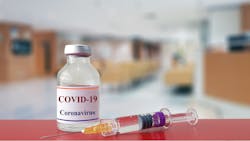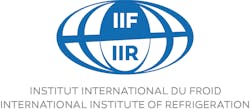The Cold Chain: A logistical challenge at the heart of vaccine distribution
Gérald Cavalier, president of the International Institute of Refrigeration (IIR) science and technology council, recently weighed in on the pivotal role the cold chain will play in the worldwide distribution of a COVID-19 vaccine.
IIR, headquartered in France, is an independent intergovernmental science and technology-based organization which promotes knowledge of refrigeration and associated technologies. Cavalier also is president of the French Association of Refrigeration and the Cemafroid Tecnea Group.
Since the beginning of 2020 and the COVID-19 pandemic, which has affected the whole world, refrigeration has been a hot topic. It’s essential to produce and distribute oxygen in hospitals, cool patients’ rooms, store and distribute medicines and food, and to support the increase of data flows caused by teleworking and lockdown. With the announcement of the availability of the first vaccines comes the question of how they’ll reach billions of people around the world, and in the shortest possible time to stop the pandemic. This is an unprecedented logistical challenge on a global scale, but also an equally unprecedented refrigeration challenge.
Thus, when Pfizer announced its COVID-19 vaccine would need to be stored at temperatures of −80°C, the cold chain, usually ignored by all, made the headlines. The world is rediscovering the importance of the cold chain and those who make it and asking many questions.
For 112 years, the IIR and its scientific and technical experts have been there to answer these questions in an independent manner. First, it’s necessary to know the real requirements of these new vaccines and their logistics, and to analyze the solutions available and identify the players ready to implement them. Then it’s possible to study the solutions to efficiently set up, in a very short time, adapted and effective temperature-controlled logistics to rapidly deploy a massive global vaccination campaign.
What will COVID-19 vaccines require in terms of the cold chain?
Many health products are heat sensitive. Their properties can be altered by temperature excursions outside a defined preservation range. This is the case with vaccines. Most of the more than 4.5 billion doses of vaccines given each year must be stored between +2°C and +8°C. From the laboratory to the patient, they are stored, transported and distributed under temperature-controlled conditions.
Downward temperature excursions generally lead to an immediate and irreversible loss of the vaccine’s full efficacy, so they should never be frozen, IRR said. Conversely, upward temperature excursions lead to progressive, cumulative and irreversible loss of vaccine efficacy. Most heat-sensitive medicines are stored between +2°C and +8°C or between +15°C and +25°C, but some health products must be stored at lower temperatures, below −20°C or even below −70°C. This is the case for frozen plasma in case of very long-term storage.
Some medicines also have different storage and distribution temperatures, e.g. storage at +2°C/+8°C and distribution at room temperature for a limited period of a few days or weeks. In 2018, eight out of the 10 best-selling medicines in the world were subject to temperature constraints.
Recent announcements by pharmaceutical companies regarding COVID-19 vaccine candidates may therefore come as a surprise. Pfizer announced storage temperatures of −80°C, and Moderna of −20°C. These are clearly far from the usual temperatures and logistics for this type of product, even though an Ebola vaccine recently was transported in dry ice below −70°C. This can be explained by the methods used to obtain these vaccines using biotechnologies such as messenger RNA, or by very short marketing lead times that do not allow all the temperature stability studies to be carried out. The Sanofi and GSK candidate vaccines, developed using the same methods as for seasonal influenza, will no doubt be satisfied with the usual logistical solutions for vaccines, i.e. +2°C/+8°C.
To date, the data provided do not make it possible to determine the real temperature requirements, from the laboratory to the patient, of all these new vaccines against COVID-19. In order to set up the solutions adapted to the needs, it is necessary to first know them well. However, it’s still possible to explore potential solutions.
What solutions exist for the distribution of a COVID-19 vaccine?
Invented in 1876 by Charles Tellier, the cold chain today is controlled, or at least controllable, and refrigeration professionals have developed solutions adapted to all types of products and temperatures, both in the health and food sectors. Nevertheless, the capacity of cold chain equipment still is very uneven on a global scale, with a gap of one to 10 between developed and developing countries, both for storage and for transport or distribution, throughout the cold chain.
From the laboratory to the patient, solutions are widely deployed for the cold chain of health products in the conventional range of +2°C/+8 °C. There is also below −20°C logistics, and more recently a +15°C/+25°C cold chain has been developed. They are used daily by dozens of cold chain specialists, logisticians, transporters, warehouses and distributors, but unfortunately, they are not yet deployed everywhere. For temperature ranges below −70°C, if they exist, the solutions remain even more confidential.
Regulations, standards and labels have been developed over the last 70 years at regional, national and global levels to guarantee the quality of this cold chain. Since its creation in 1908, the IIR has been actively involved in this, and has been a partner of the United Nations since 1970 for the implementation of the agreement on the transport of perishable foodstuffs, known as the ATP agreement, but also of the World Health Organization (WHO), which is deploying its quality and safety program (PQS) for the vaccine cold chain. The IIR also has supported the International Healthcare ColDays of the French Association of Refrigeration (AFF) since 2008 and co-published a best practice guide on the cold chain for health products.
What prospects exist for the temperature-controlled logistics of a COVID-19 vaccine?
While the cold chain for health products—and more particularly vaccines—can efficiently deliver vaccines at +2°C/+8°C almost anywhere in the world, this is not necessarily the case for large-scale vaccination campaigns with products to be stored below −20°C, and even less so at −80°C. The challenge is unprecedented, but the battle is not lost, Cavalier said.
For below −20°C products, existing and widely used solutions for frozen products can quickly be duplicated in the vaccine cold chain. They are well known, controlled, available and, in some cases, already certified.
For below −80°C products, the situation is more complex, but not hopeless. Although there is currently no significant storage and transport capacity for thermosensitive products below −80°C, technical solutions do exist. As regards storage, the air-source open-cycle refrigeration machines used for refrigeration in tuna warehouses at −60°C, for example, can also be used at −80°C. They also can be used for cold distribution chambers. For transport, nitrogen cryogenic transport units used at −20°C can also be used at −80°C with reinforced insulation boxes. When talking about temperatures close to −80°C, as often is the case with health products, dry ice plays an important role in transport, especially in insulated packaging and containers both for air transport and for land transport in combination with refrigerated trucks. There are already cabinets for storage at −80°C, especially in hospitals and laboratories.
Finally, the readjustment of the temperature of these products prior to injection should not be neglected. It is not innocuous to go from −80°C to +20°C. And launching a massive vaccination campaign with products below −80°C requires determining these means, deploying them on a large scale and training the users of this equipment.
Conclusions
The temperature-controlled logistics of the global massive vaccination against COVID-19 is a real challenge, as much for its unprecedented importance as for its technical specificity, as announced by several laboratories. Whether at temperatures below −20°C or −80°C, for all or part of the chain, new means will have to be put in place with costs significantly higher than typically implemented for vaccine logistics. This is a matter for experts and specialists. The most precise information, particularly concerning temperature requirements, must be made available as soon as possible.
The IIR and its hundreds of experts around the world are at the forefront of these issues and will provide their scientific and technical expertise on the cold chain for health products to the public and private players involved in these operations: governments, health agencies, hospitals, pharmaceutical laboratories and, more broadly, health and logistics professionals. All these experts are already at work to provide concrete answers and face the challenge of the global massive COVID-19 vaccination.
For more information, visit iifiir.org.

